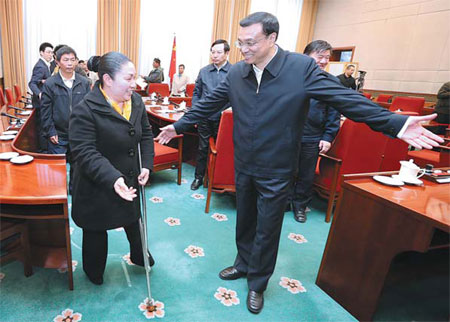Rural doctors bring hope
Updated: 2013-01-09 07:32
By Yang Wanli and Tang Yue (China Daily)
|
||||||||
Arduous treks and difficult conditions must often be negotiated before patients in isolated areas get medical treatment, report Yang Wanli and Tang Yue.
Losong Gyaltsen left his home in the Tibet autonomous region on New Year's Eve and set off on his first trip outside the area.
Despite the title "village doctor", the 33-year-old doesn't actually hold a medical degree, but is licensed to provide basic services in rural areas.
Like many people, the young man was looking forward to seeing Tian'anmen Square, but one place he never imagined he would visit was his "biggest surprise" - Zhongnanhai, the residential compound for China's top leaders in downtown Beijing.
Although the January day was sunny, the wind was bitterly cold. Losong Gyaltsen recalled the moment Vice-Premier Li Keqiang entered the room. "I was too nervous to speak, so I just kept saying 'hello'," he said.
The vice-premier met with 18 village doctors from across the country. All work in rural areas, but Losong Gyaltsen was the only one from Tibet. In his 18 years in Shading county, in the east of the region, he has delivered more than 500 babies, many of whom had extremely difficult births.
Serving around 2,000 residents in 16 villages, 13 of which have no access to good roads, Losong Gyaltsen relies on his horse. A one-way trip to a village can take as long as seven days and he is accustomed to carrying supplies of food and water on his rounds.
He often crosses 5,000-meter-high mountains where the winter snow can reach as high as his knees and stones made unstable by the heavy flow of water crash into the ravines far below.
Losong Gyaltsen is among 1 million village doctors operating out of 648,000 health centers and providing treatment for isolated communities. However, low pay, harsh living conditions and a lack of new talent entering the field make life hard for many of Losong Gyaltsen's more senior colleagues, half of whom are aged 50 or older.
Those aged between 20 and 29 account for just 7 percent of the total, according to a 2012 report by the Ministry of Health. The poor working conditions and a negligible chance of promotion mean the younger generation looks elsewhere for more lucrative and easier ways of making a living.

 Li Na on Time cover, makes influential 100 list
Li Na on Time cover, makes influential 100 list
 FBI releases photos of 2 Boston bombings suspects
FBI releases photos of 2 Boston bombings suspects
 World's wackiest hairstyles
World's wackiest hairstyles
 Sandstorms strike Northwest China
Sandstorms strike Northwest China
 Never-seen photos of Madonna on display
Never-seen photos of Madonna on display
 H7N9 outbreak linked to waterfowl migration
H7N9 outbreak linked to waterfowl migration
 Dozens feared dead in Texas plant blast
Dozens feared dead in Texas plant blast
 Venezuelan court rules out manual votes counting
Venezuelan court rules out manual votes counting
Most Viewed
Editor's Picks

|

|

|

|

|

|
Today's Top News
Boston bombing suspect reported cornered on boat
7.0-magnitude quake hits Sichuan
Cross-talk artist helps to spread the word
'Green' awareness levels drop in Beijing
Palace Museum spruces up
First couple on Time's list of most influential
H7N9 flu transmission studied
Trading channels 'need to broaden'
US Weekly

|

|








